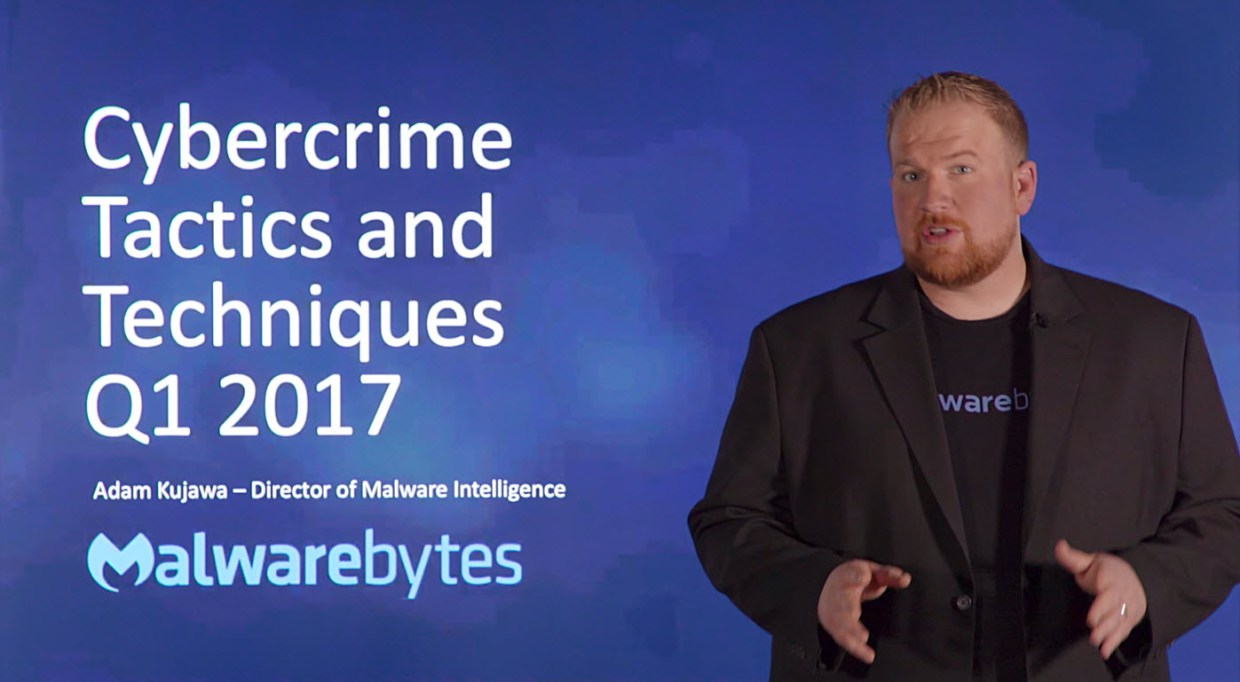The first quarter of 2017 brought with it some significant changes to the threat landscape and we aren’t talking about heavy ransomware distribution either. Threats which were previously believed to be serious contenders this year have nearly vanished entirely, while new threats and infection techniques have forced the security community to reconsider collection and analysis efforts.
In our second Cybercrime Tactics & Techniques report (read the first one here), we are going to take a deep look at what threats got our attention the most during the first three months of the year, what we expect to happen moving through the next quarter and a behind the scenes interview with one of our Malwarebytes Labs analysts. Here is a sneak peek at what we are going to cover:
- Cerber ransomware took over as the top dog as far as distribution and market share.
- Locky ransomware has dropped off the map, likely due to the desired change by the controllers of the Necurs spam botnet; however, with a lack of new Locky versions being developed since before the beginning of the year, the fate of its creators are unknown.
- The Mac threat landscape saw a surge of new malware and backdoors in Q1 2017, including a new Mac ransomware (FindZip).
- On the Android side, two notable malware families have been causing a lot of trouble. HiddenAds.lck, which locks the device from being able to remove the app, therefore allowing for more advertisement revenue for the creators, and Jisut, a mobile ransomware family that has been spreading like wildfire.
- In the exploit kit world, RIG continues to have the greatest market share of the few exploit kits that are still active and we expect this to continue. RIG exploit kit remains on top mainly due to its lack of competition rather than its technical sophistication.
- Malicious spam campaigns have also started utilizing password protected zipped files and protected Office documents to evade auto analysis sandboxes utilized by security researchers.
- In social media scams, users were bombarded with links to WWE nude photo dumps that lead to gift card survey scams.
- Tech support scammers, finding difficulty working with North American payment processors, have begun accepting alternate forms of payment, such as Apple gift cards and bitcoin.
Looking ahead to the second quarter of the year:
- We expect to see continued heavy distribution of Cerber through Q2 2017 due to new developments made to the malware design and its continued use of the ransomware as a service (RaaS) model.
- As far as Cerber losing its crown, it is unlikely within the next quarter that any competitor will rise in market share enough to dethrone Cerber, barring something happening to the developers of Cerber and their ability to develop and distribute the ransomware.
- The continued heavy development of Mac malware throughout Q2 is highly likely.
- The Android ransomware Jisut is expected to continue its trend of high distribution and spread. We predict the same for HiddenAds.lck.
- Distribution mechanisms are likely going to develop new features and functionality, be it through social engineering tactics utilized by exploit kits and malicious spam or from the discovery of new exploits, potentially revitalizing the exploit kit market.
- Finally, in the world of scams, we expect to see an uptick of ‘exit scams’ and tech support scammers utilizing social media advertising to scam each other. At the same time, we predict the increase collaboration of PUPs and TSS through the spread of tech support scammer advertisements being pushed alongside potentially unwanted programs.
Download full report here
Thanks for reading and safe surfing!









